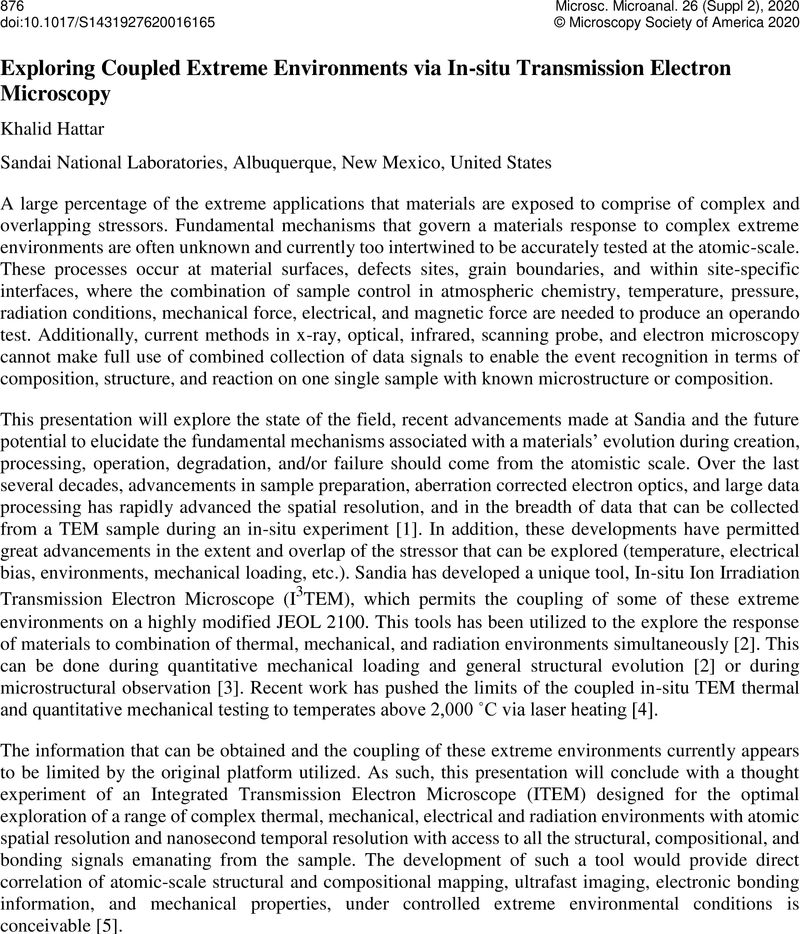No CrossRef data available.
Article contents
Exploring Coupled Extreme Environments via In-situ Transmission Electron Microscopy
Published online by Cambridge University Press: 30 July 2020
Abstract
An abstract is not available for this content so a preview has been provided. As you have access to this content, a full PDF is available via the ‘Save PDF’ action button.

- Type
- In situ TEM at the Extremes - Radiation Damage
- Information
- Copyright
- Copyright © Microscopy Society of America 2020
References
Robertson, Ian M., Schuh, Christopher A., Vetrano, John S., Browning, Nigel D., Field, David P., Jensen, Dorte Juul, Miller, Michael K. et al. “Towards an integrated materials characterization toolbox.” Journal of Materials Research 26, no. 11 (2011): 1341–1383.10.1557/jmr.2011.41CrossRefGoogle Scholar
Jawaharram, Gowtham Sriram, Price, Patrick M., Barr, Christopher M., Hattar, Khalid, Averback, Robert S., and Dillon, Shen J.. “High temperature irradiation induced creep in Ag nanopillars measured via in situ transmission electron microscopy.” Scripta Materialia 148 (2018): 1–4.10.1016/j.scriptamat.2018.01.007CrossRefGoogle Scholar
Bufford, Daniel C., Barr, Christopher M., Wang, Baoming, Hattar, Khalid, and Haque, Aman. “Application of In Situ TEM to Investigate Irradiation Creep in Nanocrystalline Zirconium.” JOM 71, no. 10 (2019): 3350–3357.10.1007/s11837-019-03701-7CrossRefGoogle Scholar
Grosso, Robson, Muccillo, Eliana NS, Muche, Dereck NF, Jawaharram, Gowtham S., Barr, Christopher M., Monterrosa, Anthony M., Castro, Ricardo HR, Hattar, Khalid, and Dillon, Shen J.. “In situ Transmission Electron Microscopy for Ultrahigh Temperature Mechanical Testing of ZrO2.” Nano Letters (2020).10.1021/acs.nanolett.9b04205CrossRefGoogle ScholarPubMed
This work was supported by the U.S. Department of Energy, Office of Nuclear Energy under DOE Idaho Operations Office Contract DE-AC07- 051D14517 as part of a Nuclear Science User Facilities experiment. This work was performed, in part, at the Center for Integrated Nanotechnologies, an Office of Science User Facility operated for the U.S. Department of Energy (DOE) Office of Science. Sandia National Laboratories is a multimission laboratory managed and operated by National Technology & Engineering Solutions of Sandia, LLC, a wholly owned subsidiary of Honeywell International, Inc., for the U.S. DOE's National Nuclear Security Administration under contract DE-NA-0003525. The views expressed in the article do not necessarily represent the views of the U.S. DOE or the United States Government.Google Scholar



